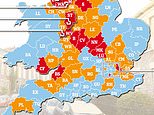We live at the start of a cul-de-sac. It's always been relatively quiet, but recently, a boy racer is driving me – and other neighbours – crazy.
I'm not sure if he has recently passed his test, or has just moved in further down the cul-de-sac, but he drives at high speeds in an older car with one of those really 'throaty' exhausts, possibly as it's modified.
As a result, he whizzes past the house, wakes us up at all hours and recently, almost mowed down me and my young children when we were leaving our front door to walk to school. I tried to give him an earful but he simply drove off with a wheelspin and a grin.
I've left a note on his car windscreen stating that the road has young families and pets, and to please be more considerate, but it's not made an iota of difference.
What can I do next? I think all it would take is the police to clock him going a mad speed in our road to stop him, but can't imagine that happening…

Jane Denton, of This is Money, replies: Depressingly, the tide of anti-social and criminal behaviour on our streets seems to be ever-increasing. Where are the tough penalties and sentences required?
This boy racer is putting your family and others on your street in danger and causing a nuisance. Speeding is a criminal offence and can lead to penalty points or a disqualification and a fine, in addition to possible court costs.
It's unfortunate, but not surprising, that leaving a note on his car windscreen failed to rectify the problem.
You've told me the culprit lives 15 doors down from you. If he lives with family, you could, along with one or two others affected on your street, go to the house in question and calmly and clearly outline your grievances to them.
This won't be possible or viable in all cases and shouldn't be pursued if you think your safety could be at risk.
As a starting point, make a note of all the times, dates and details the incidents are occurring.
Keeping a log like this will prove useful when dealing with your local council or police later down the line, should you choose to take the matter further.
I've asked two legal experts for their views on the issues you've raised.

Sunjay Versani, director of criminal law at Duncan Lewis, says: Unfortunately, many communities are increasingly affected by noise and disruption from inconsiderate drivers, often called 'boy racers.'
This behaviour can cause a serious disturbance, especially in quiet residential areas.
However, there are steps you and your neighbours can take to address the issue, though some may take time and may not immediately stop the disruptive behaviour.
Since you have already left a note on the car, it might also be worth calmly approaching the driver's family and discussing your concerns when the driver and car are not present.
If this approach does not help, it is worth reporting the behaviour to the police.
While there is a perception that the police may be too busy, they do have a duty to address reckless and careless driving in residential areas, which can be classified as dangerous driving or driving without due care and attention.
Gather as much evidence as possible -video recordings with timestamps of the careless driving are very helpful.
Noise-detecting cameras can also record vehicles and noise levels, which can lead to fines if used by the police.
You can contact your local police on the non-emergency number 101 and explain the safety risks posed by the driver's behaviour.
Enlisting the support of other neighbours when raising this complaint can also increase the chance of action, as councils and police are often more responsive to community-wide concerns.
Your local council's community safety team may also have initiatives to address anti-social behaviour.
Councils sometimes work with police to install traffic calming measures, like speed bumps or signage, particularly if multiple residents report the same issue.
If the problem persists, ask the council or police about the possibility of issuing a Public Spaces Protection Order, which can restrict anti-social activities such as loud revving and racing.
In serious cases, an Anti-Social Behaviour Order might be used to limit disruptive activity.
Repeated disturbances, like excessive noise and reckless driving, may qualify.
As a last resort, you could consider a civil nuisance complaint. This requires proving that the driver's actions harm your property enjoyment, which may involve legal advice and is a longer process with no immediate guarantees.
Whatever steps you choose, document all incidents thoroughly.
Comprehensive evidence will help the police and council understand the impact of this behaviour on your community, and the more neighbours who support the complaint, the higher the chances of achieving a positive resolution.

Declan Storrar, a solicitor at Hodge Jones & Allen, says: It is very unfortunate that you find yourself in this position. While it is frustrating and disruptive, you may have a few options available to you.
You will normally have to work with your local council and local police service in order to achieve a resolution.
In the first instance, you should report the speeding incidents as they happen to your local police.
The more reports you log, the more information there will be for the police to consider whether they should or would be willing to take action.
The police are unlikely to take action when there is a lack of complaints or evidence to the contrary.
You can normally submit information or reports to the police online or via the 101 non-emergency number.
In some cases and with sufficient evidence, the police may decide to take direct action against the individual you are raising a complaint against.
In addition to the reports to the policing department, once you have sufficient evidence, you can also report this matter to your local council and to your local councillor.
In support of your complaint, you could provide additional evidence such as witness statements from local residents, videos, doorbell camera recordings - subject to compliance with separate legislations - diaries of incidents and police incident numbers from the reporting to 101.
Your local council is ultimately responsible for setting local speed limits and introducing traffic calming measures such as speed humps and chicanes.
You could make an application to your council for a permanent Traffic Regulation Order.
This will prompt your council to carry out an assessment to decide if traffic calming measures are feasible, necessary and within the councils' budget.
If the council believes this to be the case, then a further detailed assessment will be carried out and you will be informed of the results.
Should your application be successful, it may be postponed until the council's following financial year or budget.
It is important to note that in the event your council refuses to place traffic calming measures, you cannot take traffic calming action into your own hands.
Any attempt to place calming measures on public roads is considered an illegal obstruction of highways and streets which if you are found guilty of, carries a penalty of imprisonment or a fine or both.
As an alternative to the process set out above, you may have recourse in tort or private prosecution. However, you would need to seek legal advice about this.












